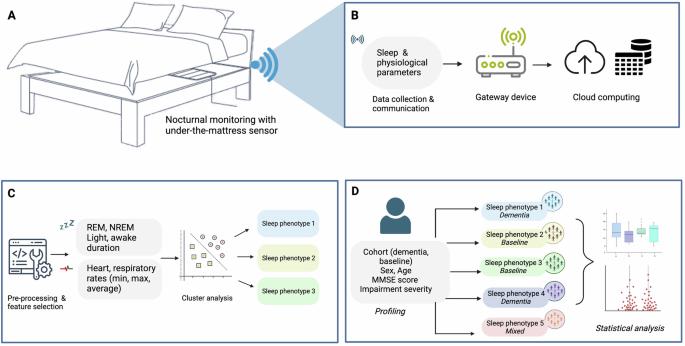Assessment of sleep patterns in dementia and general population cohorts using passive in-home monitoring technologies
IF 5.4
Q1 MEDICINE, RESEARCH & EXPERIMENTAL
引用次数: 0
Abstract
Nocturnal disturbances are a common symptom experienced by People Living with Dementia (PLWD), and these often present prior to diagnosis. Whilst sleep anomalies have been frequently reported, most studies have been conducted in lab environments, which are expensive, invasive and not natural sleeping environments. In this study, we investigate the use of in-home nocturnal monitoring technologies, which enable passive data collection, at low cost, in real-world environments, and without requiring a change in routine. Clustering analysis of passively collected sleep data in the natural sleep environment can help identify distinct sub-groups based on sleep patterns. The analysis uses sleep activity data from; (1) the Minder study, collecting in-home data from PLWD and (2) a general population dataset (combined n = 100, >9500 person-nights). Unsupervised clustering and profiling analysis identifies three distinct clusters. One cluster is predominantly PLWD relative to the two other groups (72% ± 3.22, p = 6.4 × 10−7, p = 1.2 × 10−2) and has the highest mean age (77.96 ± 0.93, p = 6.8 × 10−4 and p = 6.4 × 10−7). This cluster is defined by increases in light and wake after sleep onset (p = 1.5 × 10−22, p = 1.4 × 10−7 and p = 1.7 × 10−22, p = 1.4 × 10−23) and decreases in rapid eye movement (p = 5.5 × 10−12, p = 5.9 × 10−7) and non-rapid eye movement sleep duration (p = 1.7 × 10−4, p = 3.8 × 10−11), in comparison to the general population. In line with current clinical knowledge, these results suggest detectable dementia sleep phenotypes, highlighting the potential for using passive digital technologies in PLWD, and for detecting architectural sleep changes more generally. This study indicates the feasibility of leveraging passive in-home technologies for disease monitoring. Rigny et al. evaluate passive in-home nocturnal monitoring in real-world settings to identify distinct sleep pattern sub-groups between people living with dementia and the general population. The feasibility of using these technologies for screening dementia-related sleep signatures and monitoring broader sleep changes is demonstrated. People living with dementia commonly sleep poorly at night, and this often occurs before they are diagnosed with dementia. We investigated whether a sleep sensor placed under a person’s mattress could monitor sleep activity in people with dementia without disrupting their normal daily routines and behaviour. We compared sleep data collected from both people with dementia and the general population to identify whether differences could be detected. We found identifiable dementia-related sleep patterns, suggesting sleep sensors could be used both to monitor disease and more generally in research. In the future, using these types of sensors could enable better care for people living with dementia by monitoring their sleep.

利用被动式居家监测技术评估痴呆症患者和普通人群的睡眠模式。
背景:夜间睡眠障碍是痴呆症患者(PLWD)的常见症状,而且往往在确诊前就已出现。虽然睡眠异常的报道屡见不鲜,但大多数研究都是在实验室环境中进行的,这种环境既昂贵又具有侵入性,而且不是自然的睡眠环境。在这项研究中,我们调查了居家夜间监测技术的使用情况,这种技术可以在真实世界的环境中以低成本被动收集数据,而且不需要改变日常作息:方法:对自然睡眠环境中被动收集的睡眠数据进行聚类分析,有助于根据睡眠模式确定不同的子群体。分析使用的睡眠活动数据来自:(1)Minder 研究,收集 PLWD 的居家数据;(2)普通人群数据集(合计 n = 100,>9500 人-夜):无监督聚类和特征分析确定了三个不同的聚类。其中一个群组与其他两个群组相比主要是 PLWD(72% ± 3.22,p = 6.4 × 10-7,p = 1.2 × 10-2),平均年龄最高(77.96 ± 0.93,p = 6.8 × 10-4,p = 6.4 × 10-7)。与普通人群相比,这组患者的光照和睡眠开始后唤醒次数增加(p = 1.5 × 10-22, p = 1.4 × 10-7 和 p = 1.7 × 10-22, p = 1.4 × 10-23),眼球快速运动(p = 5.5 × 10-12, p = 5.9 × 10-7)和非眼球快速运动睡眠持续时间(p = 1.7 × 10-4, p = 3.8 × 10-11)减少:这些结果与当前的临床知识相符,表明可检测到痴呆症睡眠表型,突出了在 PLWD 中使用被动数字技术的潜力,以及更广泛地检测结构性睡眠变化的潜力。这项研究表明,利用被动式家用技术进行疾病监测是可行的。
本文章由计算机程序翻译,如有差异,请以英文原文为准。
求助全文
约1分钟内获得全文
求助全文

 求助内容:
求助内容: 应助结果提醒方式:
应助结果提醒方式:


